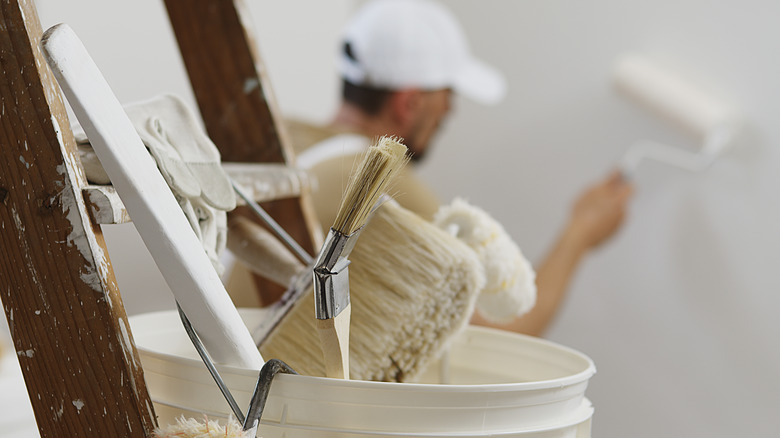What's The Difference Between Eggshell And Matte Paint?
We may receive a commission on purchases made from links.
Painting your walls seems like a relatively simple task, but many factors must be considered. Choosing your colors is the fun part of the decision, but settling on a finish can leave your head spinning, especially if you're new to the world of home improvement. To help simplify this difficult choice, we'll discuss the pros and cons of two of the most common finishes for interior paints: eggshell and matte.
According to Benjamin Moore, paint finishes have seven options, ranging from flat to high-gloss. Eggshell and matte finishes sit next to each other on this paint spectrum and don't veer into extremes, making them a popular choice for interior walls and ceilings. While they may appear similar at first glance, both finishes have different characteristics regarding durability, sheen, and forgiveness of imperfections. Keep reading to learn more about the differences between these two paint types and what home projects they're best suited for.
Matte paints
Matte paints do not have much luster. They have a minimal sheen, so they don't reflect light as quickly as an eggshell finish and absorb it instead. This makes walls look more uniform and smooth and does an excellent job covering up any minor textural imperfections in the drywall, like patches or small bumps. They also provide incredible depth of color to allow those selections you spent hours choosing to shine. As a cherry on top, they're typically slightly more economical than higher-sheen finishes.
The downside? They're not quite as durable as an eggshell finish and more easily reflect dirt and oil marks in high-traffic areas, like kitchens and living rooms. Because of this, Benjamin Moore recommends using matte paints for ceilings and spaces that don't take a lot of damage, like bedrooms and dining rooms. Consider washable matte paint if you want the best of both worlds. It combines the look of a low-sheen matte finish with enough durability to withstand cleaning, but it still doesn't hold up quite as well as eggshell.
Eggshell paints
Eggshell is slightly more reflective than matte paint but still doesn't read very shiny, just like an actual eggshell. Instead of the chalky texture of matte, it has a subtle sheen that reflects a bit of color throughout the room. It's the solid middle ground for most interior walls. Unless you're dealing with some seriously sticky fingers or kitchen grease splatters, it's durable enough to withstand daily wear and tear. Because of this, eggshell is one of the most popular finishes across the board, per Home Depot. It's well-suited for a variety of projects, but if you're a die-hard fan of the completely matte look, it may not be for you.
Both matte and eggshell paints have pros and cons, but they are also well-suited for different looks and projects. Essentially, if camouflage is your goal, go for true matte. If you want more durability while maintaining a similar look, bump it up to an eggshell finish.


